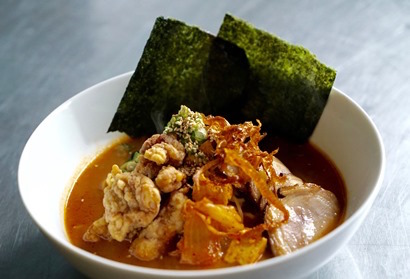

A super catering company leading the culinary industry
By Elli Sekine
Catering company “Kawashima’s Kitchen,” serving an average of 750 meals a day with approximately 1,200 contracted corporate clients, prepares food without rest from early morning to evening.
We visited the kitchen that receives orders for over 1,000 meals on a busy day. The staff were surprisingly calm, with each person handling their areas of responsibility dutifully. Sixth year since the company opened, the catering company does not bend to the pressures of various tasks and long hours, but has an efficient flow in their work from purchasing to the disposal process where. Kenichi Kawashima, Executive Chef and Manager of “Kawashima’s Kitchen” manages a trendy restaurant serving Japanese-Western cuisines. Despite the restaurant’s growing popularity, Kawashima was drawn to
the catering business that was started concurrently, and changed directions.
At the same time, the catering market in the Bay Area was rapidly expanding.
Kawashima’s turning point in his business and the timing for the market expanding matched. Most of the clients of “Kawashima’s kitchen” were IT companies. The food service that was started to improve the performance of staff members, was now diversified to service meetings and parties, while the catering services also started concurrently.
When interviewing Kawashima, a method to practice his “own style of management” that was easier to control, compared to running a restaurant, became more apparent.
JRN: What made you decide to start a catering business?
Kawashima: In the beginning, we took our stock pot to the kitchens of businesses to provide our catering services. It was at a time when the ramen boom had just started, and noone was catering ramen yet. Our ramen was well received for having exceeded our customers’ expectations. I personally think that if we draw the line and decide that achieving a performance level of approximately 60 percent is acceptable for the catering business, we could run it more efficiently.
JRN: The menu lists selections such as Bibimbap, however, how is this dish prepared and served on site?
Kawashima: Initially, we separate the food ingredients. I think this turning point in our thinking led us in the right direction. Cut them separately with each dish prepared individually on site. Since there are no set rules on “how it must be served,” some customers arrange the food ingredients separately in the dish. However, the dish is well-received, and this makes creating our menu selections fun.
JRN: What is attractive about the catering business compared to the restaurant industry?
Kawashima: It’s because it’s easy to control, first and foremost. My personality is also suited for this work. When I was running a restaurant, my worries were endless. For example, if one server doesn’t come in for a shift, that impacts the entire shift, and we have no clue how many customers will come that day. But now, if one staff can’t come in, I can step in. Also, we purchase our food ingredients according to the number of customers we’ll have. Since I know which days we’re busy, the greatest advantage is that I can eliminate food waste and unnecessary manpower too.
JRN: How did your business gain popularity?
Kawashima: I believe our job is more than merely transporting and serving food to customers, but our ‘performance’ is also part of our service.
Since employees of IT corporations sit in front of a computer all day, they look forward to their lunch hour. So for example, I created a menu titled, “Build Your Own Ramen,” where the noodles are boiled on site, and customers select their choices of food ingredients. On days that we serve sushi, we prepare our sushi by hand directly in the cafeteria of client companies, and I believe that is our job.
JRN: What part of the menu are you especially fastidious about?
Kawashima: More than the menu itself, I’m more concerned about satisfying the customers individually. I started to learn what customers were wanting by communicating with the floor manager in charge of our lunch service. Of course, we have our recommended menu selections. However, our service is also unique for proposing the
catering menu according to the preferences of each customer.
JRN: I’ve learned you practice an ecofriendly management style. In what areas do you apply this practice?
Kawashima: I have a policy of basically using up our food ingredients and trying our best to eliminate waste. When I come across other corporate lunches, I see mounds of food ingredients go to waste, or a large pile of trash after the large service is over. I can say
the same about the boxed “bento” business too. From the perspective if higher efficiency, it makes sense to deliver the food in a large container, then dividing them into smaller portions, which also is an eco-friendly practice. We are creative with our food ingredients, like taking vegetable stems usually thrown away, and prepare them as pickled vegetables, or marinate them in “koji” (rice malt) to create another side dish. To serve a quality dish, it’s also important to not add too many food ingredients. Recently, I hear that Uber is being implemented into the delivery system. I think another way to eliminate waste is to rely on (delivery) experts.
Kawashima’s “own style of management” consists of one important factor, to “have control.” By applying flexibility, developing a unique menu becomes fun. Also, since catering service is background work behind the front lines, where customer feedback is received on-site, I receive great motivation as a chef. Kawashima proved that catering service is a food business with tremendous potential for the future.
料理業界をリードするスーパーケータリーング
1日平均750 食、約1200社の契約企業を持つケータリング会社、「Kawashima’ s Kitchen」では、早朝から夕方まで休む暇なく料理を作っている。多い時は1000食を超える注文を受けるそのキッチンを訪ねてみると、従業員達は意外と落ち着いて、各持ち場を淡々とこなしていた。同ケータリング会社は起業して今年で6年目。日々時間に追われる業務内容にも屈せず、仕入れから廃棄処理までの一連の流れに無駄がないように思えた。「Kawashima’skitchen」の経営者で料理長の川嶋研一氏は以前、和洋食を扱うトレンディなレストランを経営していた。人気は上昇していたにも関わらず、並行して始めたケータリングビジネスの方に魅力を感じ方向転換した。同時期、ベイエリアのケータリング市場はうなぎのぼり。まさに川島氏の転換期と市場拡大の時期が合致したようだ。
「Kawashima’s kitchen」の顧客はほとんどがIT企業だ。従業員のパフォーマンス向上の為に始まった食事サービスは、今ではその用途も会議やパーティーまでと多様化し、それに伴いケータリングも進化している。川嶋氏に話を伺うと、レストランに比べ、コントロールがしやすい「自分らしい経営」の手法が見えてきた。
JRN:ケータリングを始めるきっかけは?
川嶋:最初は、企業の食堂に寸胴を持って行きケータリングをやっていました。
その頃ラーメンブームのはしりでしたが、まだ誰もラーメンのケータリングはやっていませんでした。期待以上に美味しいものが食べられるという事で評価を得たようです。私はケータリングは60点くらいの出来で良いと割り切った方が効率を図れると思っています。
JRN:メニューにはビビンバなどもありますが、現地でどのように取り分けるのですか?
川嶋:一度食材別に全て壊します。この発想の転換が良い方に進んだ気がします。材料を全て別に作り、現地で各自が盛り付ける手法にしています。「こういう風に出さなければいけない」というルールはありませんから、バラバラに盛って食べる方もいます。でも結果は好評で、メニュー作りも楽しくなります。
JRN:レストランと比べてケータリングビジネスの良さとは?
川嶋:コントロールがしやすいというのが一番かな。自分の性格もあるので、私はこの仕事に向いていると思いました。レストランを経営していた頃はいつも心配事が絶えなかった。例えば、サーバーが一人休むとシフトも変わってくるし、お客さんがどのくらい入るか日によってわからない。でも今だと、もし一人休んでも僕が代行ができるし、きっちり人数分の食材を仕入れ、忙しい日もわかっているので、食材や人材の無駄を省けるのが大きなポイントです。
JRN:どのようにして人気を獲得されたのでしょうか?
川嶋:ただ食を運ぶだけではなく、パフォーマンスも一つのサービスだと思っています。IT企業の従業員は皆一日中コンピュータの前に座っているので、ランチを楽しみにしているのです。例えば、「BUILD YOUR OWN RAMEN BAR」というメニューを作り、現場で麺を茹で、好きな具を選んで頂きます。寿司の日は、顧客企業のカフェテリアで寿司を握り、楽しんでいただくのも私達の役割です。
JRN:メニューのこだわりなどはありますか?
川島:メニューのこだわりより客に合わせて満足していただくのが大切です。ランチサービスを担当するフロアマネージャーとのコミュニケーションで、顧客が何を望んでいるかという事がわかるようになりました。もちろんオススメメニューはありますが、顧客に合わせてケータリングメニューを考案できるのも、このビジネスの特徴です。
JRN:先ほどの「無駄を省く」というエコ経営をどのように実践していますか?
川嶋:基本的に材料を使い切り、ゴミをなるべく出さないというポリシーを持っています。他の企業ランチに遭遇すると、山のように食材を捨てたりランチの後には大量のゴミが出ます。弁当の形態も同じことです。もっと効率的に考えた場合、大きな容器で配達して小分けした方が、エコにつながります。食材も普段捨てる茎の部分を料理したり漬物にしたり、麹でマリネードして別のおかずにしたりと工夫しています。良いものを出すには、食材を増やしすぎない事も大事です。最近ではUberを使った配達システムも導入されています。専門家に任すというのも無駄を無くす方法だと思います。
川嶋氏の“自分らしい経営” には、“コントロールができる” という大きな要素がある。柔軟性を持たせ、ユニークなメニュー開発の楽しみもある。それに現場で人々のフィードバックも伺える最前線の裏方なので、モチベーションも上がるようだ。ケータリングは将来的にも多大な可能性を秘めた食ビジネスであることを同氏が証明してくれた。
Kawashima’s Kitchen
(415) 238-4447
Serving San Francisco and surrounding area
open hour: 24h
Website